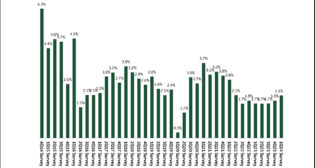
What cant can and can’t do
Written by Douglas John Bowen
Curve design for balance speed conditions is not practical for all operating conditions. How can improved track design help vehicle and track curving performance?
As part of the Association of American Railroads’ Strategic Research Initiative (SRI) Program, Transportation Technology Center, Inc. (TTCI) is quantifying the effect of track cant on vehicle curving to establish whether vehicle and track curving performance might be improved through improved track design, thereby reducing wheel and rail and track maintenance costs.
Elevation of the high rail above the low rail (track cant) introduces a force on the vehicle to the inside of the curve. This force opposes the force to the outside of the curve due to centripetal acceleration and counters vehicle overturning. The centripetal acceleration of the vehicle is a function of its speed and the track curvature.
There is only one speed, curvature, and track cant combination for zero net lateral force on the vehicle and for equal vertical load on the wheels in high and low rail contact; this is termed the balance speed.
Curving above this speed results in higher vertical loads on the high rail (overbalance or cant deficiency conditions). Curving below this speed results in higher vertical loads on the low rail (underbalance or excess cant conditions).
Under imbalance conditions, a further variable influences the vertical loading (the height of the center of gravity of the vehicle). For a given imbalance condition, the higher the center of gravity of the car, the greater is the vertical load transfer between high and low rail contact.
Curve design for balance speed conditions is not practical for all operating conditions. For example, vehicle speeds vary as a result of the following:
• Traffic mix (passenger vs. freight and fast freight vs. slow freight).
• Traffic direction and grade (ascending heavy trains at low speed vs. faster, lighter descending trains under braking).
TTCI has quantified the influence of imbalance conditions on vertical wheel loads as well as steering tractions across the wheel/rail contact patch. Vertical wheel loads are relatively easy to quantify given the height of the center of gravity of the car. Care should be taken to consider:
• The spectrum of vehicle types and load conditions;
e.g., in-track measurements in a 4.5-degree curve at 3-inch underbalance showed a load differential from high to low rail of 5,330 pounds for loaded coal gondolas and 7,430 pounds for loaded coal hopper (with higher center of gravity).
• The lateral and roll deflection of the vehicle suspension. This influences the vertical and lateral position of the center of gravity of the vehicle.
• The influence of coupler force and swing on vertical wheel loads. In-track vertical load measurements in the same 4.5-degree curve showed that the above mentioned load differentials increased to 7,610 pounds and 9,680 pounds immediately behind the two lead locomotives and decreased to 3,010 pounds and 5,130 pounds immediately in front of the two trailing pusher locomotives.
TTCI examined the influence of imbalance speed on steering tractions. Theory indicates that excess cant induces a larger angle of attack on the lead wheelset than for curving at balance speed (Figure 1b), increasing wheel and rail forces. Instrumented wheelset measurements under controlled imbalance conditions at TTCI confirmed the theory and showed that the lateral force is reacted almost entirely by the lead wheelset and is proportional to the degree of imbalance for a given curvature.
TTCI concluded that curving at underbalance speed particularly exacerbated the stresses in low rail contact and should be avoided if at all possible. These stresses lead to an increased propensity to form high impact wheels and to an increased propensity for low rail spalling and material flow.
The investigation concluded with suggested strategies to minimize imbalance conditions under heavy haul conditions. Further quantification of optimum design limits are anticipated as TTCI continues fundamental research under the
SRI program into the root causes for rolling contact fatigue.
See also:
• Tournay, Harry, et al. July 2014. “The Effect of Track Cant on Vehicle Curving: Theory & Single Car Test Results,” TTCI Technology Digests TD-14-013, TD-14-014, and TD-14-015.
• Tournay, Harry. Railway Age, April 2014, p. 55. “Rolling contact fatigue root causes.”



